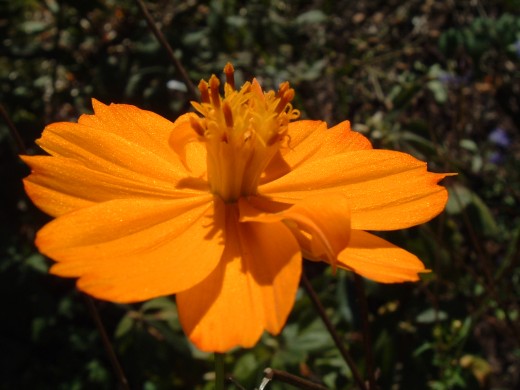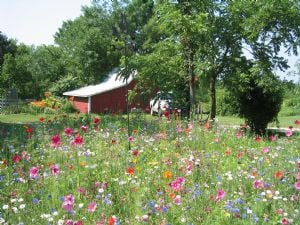Beginners Guide on How to Build and Maintain a Flower Garden
Orange Cosmos

Maintaining a flower garden takes work, but a beautiful garden is a wonderful reward. Knowing how to properly care for your flower garden will help increase your enjoyment of it and make for a rich experience.
Be sure to start with the right gardening tools. Appropriate garden tools are invaluable and will lower the amount of time each task will take. It isn't necessary to purchase the most expensive item, but do choose quality tools. Some basic tools to consider include a digging spade, pruning shears, a soil rake and a weeding knife.
Make sure your garden contains the essentials. Fertile soil is vital to your garden's health. To prepare the soil, first remove weeds and other vegetation, and then add a couple of inches of compost or manure, and then turn the soil over with a digging spade. Rake it out, and the soil is ready. Next you will need the correct amount of sunlight and water to ensure a healthy and attractive garden. Water the garden in the early morning or late afternoon to minimize evaporation. And, be sure to follow the directions on the packaging your flowers came in.
Consider including a mix of perennial and annual flowers so the garden can flower all year long. Don't overlook flowers that are native to your region. Native plants will thrive better, and will require less water. Also, be aware of a flower's color and consider grouping flowers in contrasting colors, which can make a striking arrangement in your garden.
Be sure to learn about garden insects and how to recognize them. Cutworms, cabbage worms, aphids and flea beetles are some of the insects to keep away from your garden. There are also good insects that are helpful to your garden. Butterflies, beetles and bees help pollinate the flowers and the ladybug and praying mantis will help control unwanted insects.
Make sure your garden is maintained. Be sure to trim shrubs and deadhead flowers in the winter. Deadhead flowers by cutting off dead flower heads and any old growth. You will also want to fertilize your garden regularly, though be careful not to fertilize too often, as this can burn the plants. Plan to fertilize your flowers every 30 to 60 days.
You may wish to start a compost pile if you haven't yet. You can add organic material such as leaves, grass cuttings and vegetable matter. Don't include weeds or food that will attract animals. Make sure to turn the materials occasionally with a spade to facilitate decomposition. Compost is the best treatment you can give your flowers.
Maintaining a flower garden is rewarding work. With just a little effort, your flower garden can be healthy and beautiful year-round.
Relaxing Garden
Diseases Common in Flower Gardening
Flower gardening is one of the most creative and relaxing of all hobbies. But, along with this relaxation comes the possibility of having to deal with common flower garden diseases. If left unchecked, these annoying problems can ruin a flower garden.
Even very talented flower gardeners are not immune from to the issue of flower diseases. A flower gardener’s best defense against disease is to educate themselves about what has developed in their garden. There are bacteria, fungi and viruses that can cause ill effects among all types of flowers. A few facts to keep in mind are that fungi are able to exist underneath the soil with no plants to sustain them, and bacteria and viruses require a plant (such as a flower) in order to survive.
A fungus is an organism that produces multiple spores that can be very difficult to remove from a flower garden. These rapidly reproducing spores can quick gain a stranglehold on an unsuspecting flower garden. Spores can attack underground through the roots or above ground by attacking the leaves and petals of flowers. One reason that a fungus is such a formidable foe to flower gardeners is that it is able to survive for long periods of time, just waiting for the right opportunity to strike. If just a single flower in your garden is infected with a fungus it can produce over one hundred million spores. Because of this, it is extremely important to rid your flower garden of spores as quickly as possible.
Bacteria that can affect a flower garden need just the right conditions in order to cause trouble among the flowers. Bacteria require both warmth and water in order to grow and spread. Bacteria can attack flowers in a flower garden through the petals or internally by entering through small cuts that can occur on a flower.
A virus will attack a flower internally by entering the flower’s cells. These threats are extremely small and can be transmitted through insects or infected seeds. Similar to bacteria, viruses enter through the cuts that can occur on flowers.
Once a flower garden has been infected with some type of disease, you can properly determine what type of disease in afflicting the garden. Whether you are a novice or a master gardener, you may eventually need a guide that describes the effects that various diseases will have on flowers. If you are still puzzled as to what type of plant disease you are dealing with, you can consult the internet or get help from the local garden center.
Try to treat any plant diseases that are plaguing your flower garden with natural solutions. This is not only better for the environment as a whole, but will be less harsh on your delicate flowers. If it is impossible to avoid treatment methods that involve chemicals be sure to use only the minimal amounts required to avoid unintended harm to the other flowers.

- Different Types of Gardening
A great overview of the different types of gardening you can try. - How to Have a Healthy Garden
What you will need and what to do for a healthy garden. - Beginner Flower Gardening Tips








